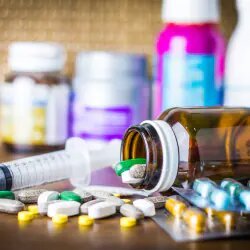Life-saving drugs play a crucial role in enhancing and preserving health, making them an essential part of our modern lifestyle. They not only treat diseases but also prevent severe complications, allowing people to lead healthier, more active lives. This article explores how life-saving drugs contribute to well-being and how they empower individuals to maintain a good quality of life.
Understanding Life-Saving Drugs
Life-saving drugs are medications specifically designed to treat, manage, or prevent diseases that could otherwise lead to serious health problems or death. The manufacturer of rifaximin is typically a pharmaceutical company specializing in antibiotics, such as Salix Pharmaceuticals or its generic equivalents, which produce this medication to treat gastrointestinal infections. These drugs are vital in addressing conditions such as cancer, heart disease, infections, and chronic illnesses. They work by targeting specific problems within the body, either by eliminating harmful agents or by correcting physiological imbalances.
How Life-Saving Drugs Impact Our Lives
- Treatment of Critical Conditions: Life-saving drugs are essential for treating serious conditions like cancer, diabetes, and heart disease. For instance, chemotherapy drugs can help manage cancer, while insulin helps regulate blood sugar levels in diabetic patients. These treatments not only improve the chances of recovery but also enhance the quality of life by managing symptoms and preventing complications.
- Prevention of Disease Progression: Many life-saving drugs are designed to prevent the progression of diseases. For example, antiretroviral drugs for HIV/AIDS help keep the virus under control, preventing the development of AIDS. Similarly, statins help lower cholesterol levels, reducing the risk of heart attacks and strokes. By managing these conditions effectively, these drugs help individuals live longer and healthier lives.
- Emergency Situations: In emergency situations, life-saving drugs can make a difference between life and death. Medications like adrenaline are used to treat severe allergic reactions (anaphylaxis), while anticoagulants can prevent blood clots from causing strokes or heart attacks. Quick and effective treatment in emergencies can save lives and reduce long-term health complications.
- Enhancing Daily Life: Beyond treating severe conditions, life-saving drugs can improve daily life for people with chronic illnesses. Medications for asthma, arthritis, and other chronic conditions help manage symptoms, allowing individuals to engage in everyday activities with fewer limitations. This not only enhances physical health but also supports mental well-being by reducing the stress and anxiety associated with managing a chronic illness.
The Role of Innovation in Life-Saving Drugs
The field of pharmaceuticals is constantly evolving, with ongoing research and innovation leading to the development of new and improved life-saving drugs. Advances in technology and science contribute to more effective treatments with fewer side effects. Some key areas of innovation include:
- Personalized Medicine: Personalized medicine involves tailoring treatments to individual patients based on their genetic makeup and specific health conditions. This approach allows for more precise and effective treatment, minimizing adverse effects and improving outcomes.
- Biologics and Targeted Therapies: Biologics are drugs derived from living organisms that target specific molecules involved in disease processes. Targeted therapies are designed to attack cancer cells or other disease-related cells without harming healthy tissues. These innovations offer more effective treatment options with fewer side effects compared to traditional therapies.
- Improved Drug Delivery Systems: Advances in drug delivery systems enhance the effectiveness of medications. For example, new formulations and delivery methods can ensure that drugs are absorbed more efficiently or reach their target sites more effectively. This can improve treatment outcomes and patient compliance.
Access to Life-Saving Drugs
Access to life-saving drugs is a critical issue that impacts health outcomes globally. Efforts to improve access include:
- Affordable Pricing: Ensuring that life-saving drugs are affordable is essential for making them accessible to everyone who needs them. Organizations, governments, and pharmaceutical companies work together to address the cost of medications through subsidies, insurance coverage, and generic alternatives.
- Distribution Networks: Efficient distribution networks are necessary to ensure that life-saving drugs reach remote and underserved areas. This includes improving supply chains, establishing local production facilities, and working with international organizations to distribute medications where they are needed most.
- Education and Awareness: Educating patients and healthcare providers about the importance of life-saving drugs and how to use them effectively can improve health outcomes. Awareness campaigns and training programs help ensure that individuals understand their treatment options and adhere to prescribed therapies.
The Future of Life-Saving Drugs
Looking ahead, the future of life-saving drugs holds promise for even greater advancements in health care. Emerging trends and technologies include:
- Gene Therapy: Gene therapy aims to treat or cure diseases by altering the genetic material within a person’s cells. This innovative approach has the potential to address genetic disorders and other serious conditions at their source.
- Artificial Intelligence (AI) in Drug Development: AI and machine learning are increasingly being used to accelerate drug discovery and development. These technologies can analyze vast amounts of data to identify potential drug candidates and predict their effectiveness.
- Global Health Initiatives: Collaborative efforts to address global health challenges, such as pandemics and endemic diseases, are crucial for improving access to life-saving drugs worldwide. International partnerships and research initiatives play a vital role in advancing global health and ensuring that life-saving treatments are available to all.
Conclusion
Life-saving drugs are a cornerstone of modern medicine, playing a vital role in treating, managing, and preventing serious health conditions. They empower individuals to lead healthier lives, manage chronic diseases, and recover from emergencies. As innovation continues to drive advancements in pharmaceuticals, the future holds the promise of even more effective treatments and improved access to life-saving drugs. By supporting these efforts and ensuring equitable access, we can work towards a healthier world where everyone has the opportunity to thrive.
